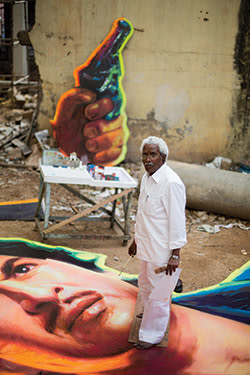First Person: ‘I’m one of the last traditional Bollywood film poster painters’
Simply sign up to the Life & Arts myFT Digest -- delivered directly to your inbox.
I was born into a family of farmers from a village in Karnataka state, in southern India, but my work took me into Bollywood, painting the promotional hoardings in front of Indian cinemas – enormous cut-outs of actors and banners advertising films.
I learnt how to paint from my guru, Shri Seenu, who lived next door to me as a child in Bangalore. My mother had taken me to live in the city, leaving my siblings and father at home in the village. She was eager to see one of her children educated but I left school at the age of nine.
For 15 years I was assistant to my guru, who specialised in Bollywood hoardings, mixing paints and sketching outlines for Rs10 (£0.10) a month. I wasn’t impassioned by art or anything but, as I learnt the skill, I began to enjoy it.

It isn’t easy, copying a small photograph to create one of these enormous cut-outs. I make the largest figures in five or six parts, which are then assembled at the movie theatre. The biggest figure I ever made was about 80ft tall. I’m 77 now, and I’ve worked on about 4,000 films.
I have assistants who build a wooden frame, stretch canvas over it and paint that with a chemical to keep it taut. After sketching the image to the correct scale, I paint the final image using colours mixed using linseed oil and especially bright pigments I get from Kolkata.
I’ve lived in Bangalore all my life, working hard when I was young and had the energy. I married when I was 24 and we had five sons. I took two jobs, working 20 hours a day. From 9am to 6pm I worked at a company called Rama Arts, painting for the film industry, earning Rs1,200 a month. In the evenings I worked in a factory painting drilling machines for Rs300 a month. It wasn’t artistic work.
I worked for eight years until I opened my own business in Bangalore in my early thirties, making hoardings for cinemas. I built up my business and eventually could even take my children on holiday, showing them India’s temples. My parents could never take me on holidays like that. I wanted to bring my sons up like kings.
Producers and distributors would see my cut-outs and seek me out – artists were highly respected and people would ask my advice on composition. One day Amitabh Bachchan, who is Bollywood royalty, came to meet me. He wanted to see who painted the posters for his films. I told him his films were doing very well in Bangalore.
I also met Rajkumar, an icon in the Kannada film industry, at a party for his film Naa Ninna Mareyalare. He liked the cut-out I painted of him and told me I should be called “Badda-appa” rather than Chinnappa – badda means “big” in Hindi.
When the industry was at its peak there were about nine companies doing this work in Bangalore. There were 10 or 15 outfits in Mumbai, the home of Bollywood, and two or three in Kolkata, each serving their own region.
Now almost nobody commissions me to promote films in the old way. It’s a shame because our work brings out emotions in those who see it, and digital printed posters can’t offer that. The rise of mechanised printing means the trade is dying.
I had 24 trainees helping me with rough work through my career, but as business slowed most of them left. In 2005, as I realised I could no longer earn a living in the film industry, I began to hold exhibitions in a small gallery I started, Rajkamal Arts, in Bangalore. I paint historical sites, such as the monuments at Hampi, which sell for between Rs75,000 and Rs100,000 a piece.
BespokeBollywood.com sells tailor-made Bollywood-style works, and I work for them too – sometimes people commission pieces, handpainted in the traditional way. You can even be painted into film posters of your favourite film.
I taught one of my sons my craft and will teach my seven grandchildren too. As technology takes over, future generations may not even understand what painting is. It’s a shame because art and colour can bring a huge amount of joy.
Photograph: Jyothy Karat
Comments